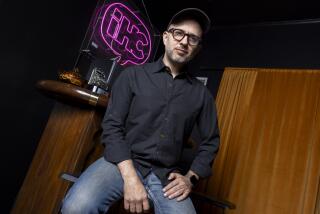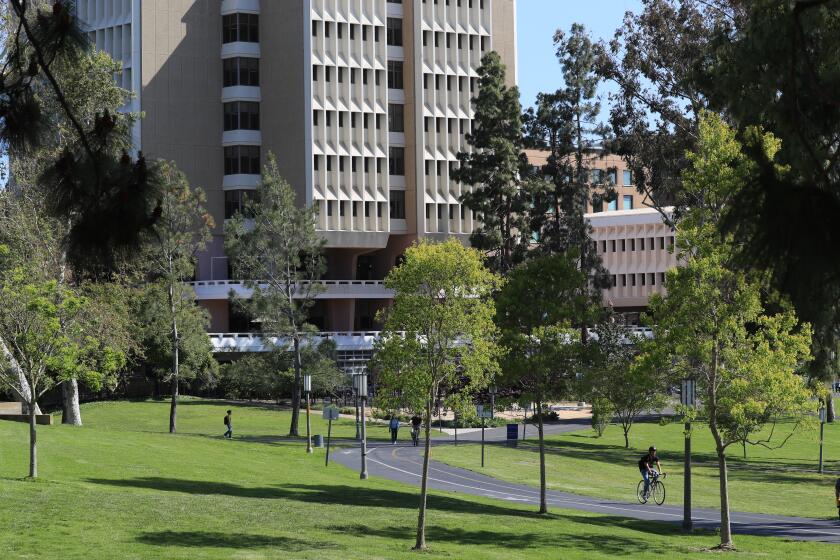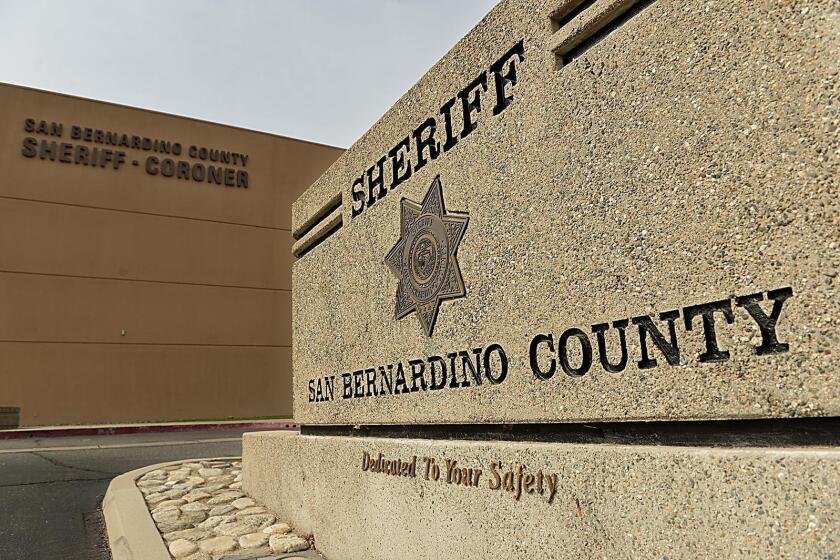Club Shone Brightly in Its Heyday
- Share via
During Hollywood’s Golden Age, Florentine Gardens nightclub more than held its own against the Cocoanut Grove, Mocambo’s, Ciro’s, the Clover Club and the Trocadero.
The Gardens on Hollywood Boulevard drew tourists by the busload, helping Hollywood forge its reputation as the world’s entertainment capital. It also drew local working people who saved up to go out on the town, paying a cover charge of $1.25 -- or $2.50 for dinner too.
For the record:
12:00 a.m. Oct. 21, 2004 For The Record
Los Angeles Times Thursday October 21, 2004 Home Edition Main News Part A Page 2 National Desk 1 inches; 54 words Type of Material: Correction
Marilyn Monroe’s wedding -- The L.A. Then & Now column in the Oct. 10 California section said Norma Jean Mortensen -- before she was known as Marilyn Monroe -- married her first husband, Jim Dougherty, at Florentine Gardens in 1942. They were married at a private home. Their wedding reception was at Florentine Gardens.
Here, future actress Yvonne De Carlo danced until her toes bled. Sophie Tucker, known as the “Last of the Red Hot Mamas,” belted out “Some of These Days.” Al Jolson dropped to one knee and, with outstretched arms, sang “Mammy.” And in 1942, Norma Jean Mortensen and her first husband, Jim Dougherty, said “I do” -- before Mortensen abandoned spouse and name to become Marilyn Monroe.
Today, the Gardens is a hip-hop club open only on weekends. Its stretch of the boulevard tends toward the seedy; there’s a shuttered X-rated theater next door. And the city is eyeing the properties to build a fire station -- unless preservationists can stave off the wrecking ball.
Yesterday was far more glamorous. The club’s floor shows starred beauty contest winners, models, singers and hoofers, many of whom went on to stardom. Fan dancer Sally Rand and the exotically named Lili St. Cyr became famous strippers.
The teenage singing and dancing duo Betty and Jane Kean put together a sister act there before appearing in dozens of films and television shows -- Jane most memorably as Art Carney’s TV wife, Trixie, on Jackie Gleason’s “The Honeymooners.”
Curvaceous Marie “The Body” McDonald eked out a living there before she was noticed in the club’s pony line and started spending time with mobster Bugsy Siegel.
The club opened Dec. 28, 1938, as a project of businessman Frank Bruni and other investors. It was designed by architect Gordon Kaufmann -- already famous for the Hoover Dam, Santa Anita racetrack, the Los Angeles Times building and Greystone Mansion in Beverly Hills.
Florentine Gardens, which cost $500,000 to build, resembles a Moorish palace with a small outside garden. According to ads in the late 1930s, it had the “largest and finest spring dance floor on the Pacific Coast.”
Its first two years were mundane -- until legendary showman Nils Thor Granlund arrived from New York.
Known as N.T.G. to the public and “Granny” to his friends, Granlund began booking high-class vaudeville acts and taking center stage as master of ceremonies in 1940.
Granlund, a figure of New York’s Jazz Age, was a purveyor of speak-easy booze in a world of hotshot gamblers, gun molls, mobsters and glamorous showgirls during the Prohibition era.
Before Hollywood beckoned, he achieved a kind of celebrity status for his elaborate nightclub productions, helping to launch the careers of such stars as Ruby Keeler, Ethel Merman, Jean Harlow and Joan Crawford. He traded stories with pals Damon Runyon and Walter Winchell, raced cars with Barney Oldfield and partied with Prince Wilhelm of Sweden.
He worked as a press agent for theater magnate Marcus Loew, a talent scout for Flo Ziegfeld and a radio announcer for New York’s WHN in 1922.
Over the airwaves, he gave young and orphaned Ruby Stevens, an acrobatic dancer, a chance to recite poetry. Stevens became better known as Barbara Stanwyck.
He bought Lucille Le Sueur a $14 evening gown. She wore it when she danced the Charleston in a nightclub act -- and into stardom as Joan Crawford.
At the club, Granlund raised chorus girls’ salaries from $30 a week to $50, still cheap compared to New York’s standard, $100. He broke the color barrier by hiring the already famous Mills Brothers, a singing quartet best known for such hits as “Glow Worm” and “Paper Doll.”
One of the audience’s and Granlund’s favorite budding actresses was Yvonne De Carlo. “Her toes were raw and bleeding, but she wanted to go on with her [dance] number,” Granlund wrote in his 1957 memoirs, titled “Blondes, Brunettes, and Bullets.” “From the very beginning, she had that indefinable something that marks the trouper.”
De Carlo was a teenager when her mother brought her to Hollywood from Canada. Granlund got her a visa and bit parts in films from 1942 to 1944. In 1945 she got her first starring role in “Salome, Where She Danced.”
“I came through these beaded curtains, wearing a Japanese kimono and Japanese headpiece, and then performed a Siamese dance,” she said in 1991. “Nobody seemed to know quite why.” In the 1960s she became famous again as Lily in the TV series “The Munsters.”
During World War II, Granlund donated about $1,000 a week for the Hollywood Guild and Canteen to feed and entertain servicemen.
Soldiers with empty pockets got into the Gardens free. Granlund always brought at least one soldier onstage and surrounded him with leggy showgirls, playing to an audience of cheering, whistling soldiers. His chorus girls got the same reaction at March Field in Riverside when they formed the shape of an airplane.
Florentine Gardens went downhill after Granlund left in the late 1940s, but continued operating as a restaurant under the same name until that, too, closed in the mid-1950s. (Granlund moved to the Flamingo Hotel in Las Vegas in 1949, going into business with Bugsy Siegel’s former partner, Moe Sedway.)
Afterward, the building served as a dental school, a salsa-rock club and, today, a venue for hip-hop nights for the 18-and-older crowd.
Its glamour long gone, the club and the defunct X Theater next door are being proposed as the site of a fire station. Made possible by a 2001 voter-approved bond measure, the station would replace 53-year-old Fire Station 82 on Bronson Avenue near the Hollywood Freeway, which the city says is too small to serve the community.
The plan to raze Florentine Gardens has the support of some Hollywood homeowners and Councilman Eric Garcetti but is opposed by preservationists and, reportedly, club owner Kenneth MacKenzie, who could not be reached for comment. Preservationists say the Community Redevelopment Agency designated the building a historic landmark in 1986, but that may not be enough to save it. The designation makes it more difficult to raze the building -- but not impossible.
More to Read
Sign up for Essential California
The most important California stories and recommendations in your inbox every morning.
You may occasionally receive promotional content from the Los Angeles Times.










